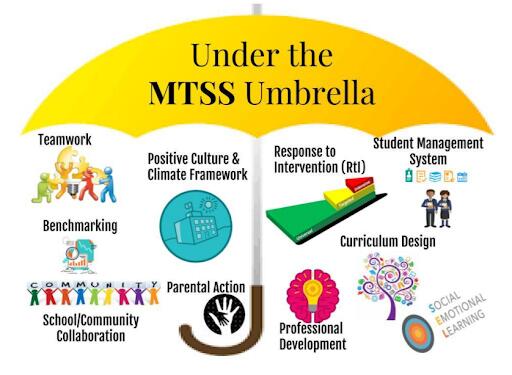Multi-Tiered Systems of Support
Multi-tiered system of supports (MTSS) is a framework many schools use to give targeted support to struggling students. You may also hear it called the MTSS framework, the MTSS process, or the MTSS model.
MTSS is designed to help schools identify struggling students early and intervene quickly. It focuses on the “whole child.” That means it supports academic growth, but many other areas, too. These include behavior, social and emotional needs, and absenteeism (not attending school).
The ‘tiers’ (levels) of support are a huge part of MTSS. They get more intense from one level to the next. For example, a child getting small group interventions may need to “move up” to one-on-one help.
Key Elements
MTSS isn’t a specific curriculum. It’s a proactive, support based approach that has these key elements:
- A schoolwide approach to student support, with teachers, counselors, psychologists, and other specialists working as a team to assess students and plan interventions.
- Universal screening for all students early in each school year
- Increasing levels of targeted support for those who are struggling
- Integrated plans that address students’ academic, behavioral, social, and emotional needs
- Professional development so staff can deliver interventions and monitor progress effectively
- Family involvement so parents and caregivers can understand the interventions and give support at home
- Frequent monitoring of students’ progress to help decide if they need more interventions
- The use of evidence-based strategies at every tier of support

River Trails School District 26 offers various levels of support to students by utilizing the following:
Tier I: Guaranteed and Viable Curriculum for ALL- Whole class instruction
All students, regardless of age and/or grade will receive a comprehensive, equitable, rigorous, and standards-based education, across all grade-levels, in all subject areas. Students may work in small groups within the classroom based on strengths and areas of need. The teacher and the school monitor all kids’ progress and may move a student to Tier 2 if they are not making progress.
Tier 2: Small Group Interventions
Classroom Students in Tier 2 still attend Tier 1 lessons with the rest of the class, but may receive more targeted support through a small group lesson called an intervention. An intervention is intentional, targeting a specific challenge. An intervention is specific and formalized. It is set for a particular amount of time and monitored closely for progress. Interventions are also flexible. The team can decide to change or edit the intervention at any given time based on the data. Intervention specialists serve as a resource to all teachers in a building. A student who isn’t making progress can stay in Tier 2 or move to Tier 3.
Tier 3: Intensive instruction
This tier can mean small group work or individual lessons. Most kids in Tier 3 still spend a lot of the day in the general education classroom. But they may spend more time with intensive instruction than when they were in Tier 2.
